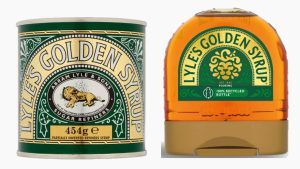Kagiso Magabe, Associate, and Zama Buthelezi, Partner, at Spoor & Fisher, discuss trade mark evolution and the legal implications of rebranding.
To adulterate the words of Shakespeare: ‘What’s in a logo? A brand with any other logo would be as distinctive.’ Until 2024, Lyle’s Golden Syrup logo was the oldest, unchanged design still in use, not having been updated since 1885. The decision to modify this logo – a dead lion swarmed by bees – has sparked widespread discussion, reflecting the delicate dance between preserving a trade mark’s legacy and modernising it to keep up with the times.
A trade mark, such as a brand name, slogan or in this case a logo, can be defined as a badge of origin that identifies the goods or services of one person from those of its competitors. Trade marks can represent a the identity of that company, encapsulating its values, heritage, and its promise to consumers. As market dynamics shift and consumer preferences change, brands often evolve while maintaining their core identity. The rebranding journey of Lyle’s Golden Syrup, a brand with over a century of history, serves as a case study of the delicate equilibrium between tradition and innovation.
History of The Lyle’s Golden Syrup’s Logo
In 1881, Abram Lyle created the iconic golden syrup now known internationally as Lyle’s Golden Syrup. Mr Lyle’s strong religious beliefs are the foundation of the legendary lion carcass swarmed by bees. Taking inspiration from the Old Testament, specifically from Solomon in the book of Judges, the logo includes a quotation from Chapter 14 Verse 14 which reads ‘out of the strong came forth sweetness’. The first rendition of the logo – depicted below, was filed on 11 October 1884.

Despite the grim fact that the logo depicts a decaying animal corpse, Lyle’s Golden Syrup’s logo remained unchanged through more than a century. In fact, the iconic logo has been recognised by the Guinness World Records as having the oldest branding in the world.

The recent unveiling of Lyle’s new logo garnered mixed reactions, underscoring the deep emotional connections that consumers have with brands. There are many reasons why business owners may want to update, refresh or even re-imagine their logos. In the current, fast-paced consumer environment, relevance is key. The new logo resurrects the lion in front-facing view and depicts a single bee above its head. Notably, and the biblical quote has been removed.
The change has been criticised by religious groups for “sidelining Christian messaging,” sparking a response from Tate and Lyle Sugars that, “religion played absolutely no part in our decision [to rebrand the syrup bottles].” Despite the backlash, Lyle’s continued use of the lion and bee motif pays homage to its age-old history. Rebranding requires a nuanced approach, one that respects consumer sentiment and brand heritage while pursuing relevance, innovation and ultimately, longevity of the brand.
The metamorphosis of logos is nothing new. In recent times, brand holders have become increasingly cautious when it comes to adopting, borrowing or retaining elements from other cultures, without having the proper understanding of that culture and for fear of claims of cultural appropriation and/or causing offense. A prime example of this would be the 2020 name change of the Washington Football team from “the Washington Redskins” to “the Washington Commanders”. The change was necessitated by views of Native Americans who complained that the name “Redskins” was disparaging and offensive to indigenous people, especially given America’s history of violence against such people.
Many familiar brands have, for various reasons, updated their logo over time while maintaining their brand identity. Other examples of the evolution of some familiar brands are shown below.


Legal Implications Of Rebranding
In addition to managing consumers’ reactions to rebranding, it is vital for business and brand owners to consider the legal implications of rebranding. The following Q&As highlight important legal principles relevant to the updating of a trade mark for use in South Africa:
Can You Rely On The Old Trade Mark Registration To Protect The Updated Logo?
Brand owners often make alterations and amendments to their trade marks. Whether or not the updated trade mark will need to be protected separately from the older trade mark by filing a new trade mark application depends on the extent of the changes made. Our law provides that a registered proprietor may apply “to add to or alter the trade mark in any manner” provided that the amendment does not substantially affect the identity of the existing registered trade mark.
In other words, where only minor alterations are made, you can apply to amend the registered trade mark. Should the Registrar accept the amendment, the amended trade mark follows the same route as all trade mark applications in that it will be advertised in the Trade Mark Journal to notify the public of the change and afford interested parties an opportunity to object to the amendment. If there is no opposition, the registered trade mark will be amended.
It is clear that Lyle’s new logo is substantially different from the old logo. Although the lion and bee theme has remained, the identity of the logo has changed so a new application will need to be filed for registration of the updated trade mark.
Can The Updated Trade Mark Be Protected?
Our legislation contains several provisions setting out criteria for marks that are considered ‘unregistrable’. When updating a trade mark, it is important to ensure that the new mark does not fall into any one of the ‘unregistrable’ categories. As an example, the new mark must still be capable of distinguishing those goods or services from the goods or services of another person , to avoid the registration of the mark being refused by the Registrar or being objected to by a third party on the grounds of non-distinctiveness.
South Africa’s rich cultural diversity necessitates a sensitivity to potential cultural, racial, or religious offence in trade mark imagery. Any mark which would be likely to offend any class of persons is deemed unregistrable. Thus, when applying to register a trade mark, the aforementioned factors concerning culture, religion and race should be considered as if not, there is a risk that the mark may be deemed offensive to a class of persons and therefore refused or opposed on this basis.
To avoid these risks, a trade mark availability or clearance search is recommended, to identify potential conflicts and also possible social, religious or cultural risks associated with the registration and use of a new or updated trade mark.
What Happens To The Older Trade Mark Registration?
Our legislation stipulates that a trade mark will become vulnerable to cancellation on the grounds of non-use if it has not been used, in good faith, for a period of five years or more from the date of registration. This means that trade mark owners must use their trade marks to avoid the registrations being vulnerable to cancellation on the grounds of non-use.
If the old trade mark is not used for a period of 5 years or more it could be vulnerable to cancellation. However, if an updated trade mark is registered, that trade mark can be formally connected to the older trade mark (by way of an “association”) and use of the updated trade mark will be deemed to be use of the associated older trade mark.
Even if the updated trade mark is not associated with the older one, provided that the updated trade mark has additions or alterations not substantially affecting the identity of the older mark, then the use of the updated mark can be argued to be equivalent to proof of the use of the older mark.
How Important Is It To Enforce An Older Trade Mark Registration Against Others?
Trade mark owners must vigilantly police the use of their marks by others and enforce their rights to prevent unauthorised use resulting in confusion amongst consumers. Enforcement is also important to prevent the dilution of trade mark registrations and to prevent the mark from becoming generic. Therefore, registrations for both the older and updated trade marks must be consistently enforced, without delay, when these are infringed.
The above being said, it must be considered that as use of the older trade mark will cease, it may become more difficult to enforce the mark as third parties will claim non-use of the older mark. In this case, provided that the older mark has acquired a reputation over the time period in which it was used, the proprietor of the older mark can claim a residual reputation in the mark. Furthermore, the use of an updated mark could be used as evidence of use of an older mark provided that the updated mark and older mark are associated and/or that the updated mark is not substantially different from the older mark.
As brand owners strive to find the sweet spot between honouring the legacy of the brand and embracing change, there are factors that must be considered and being aware of the complex mix of legal, cultural, and consumer engagement challenges is half the battle won. The updating of Lyle’s Golden Syrup is a useful case study for brand owners embarking on this journey, illustrating the nuanced approach required to successfully refresh a brand.
SPOOR & FISHER
www.spoor.com










